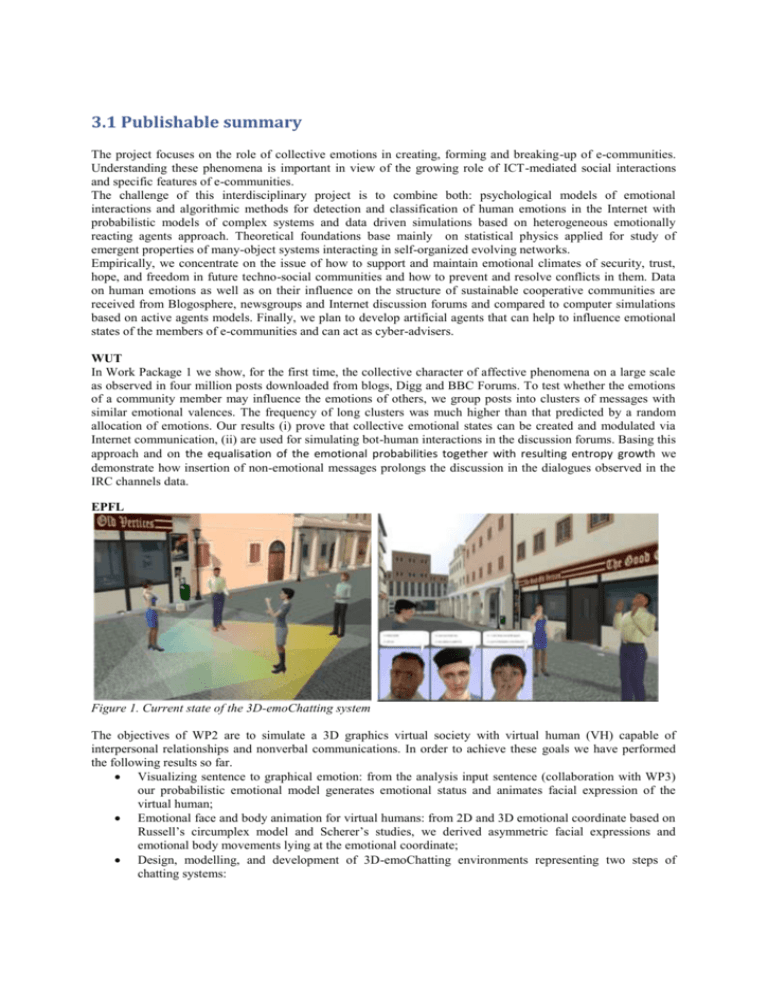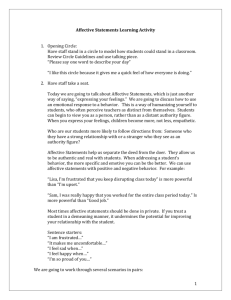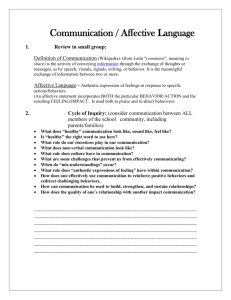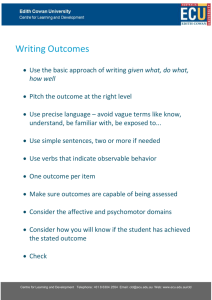3.1 Publishable summary
advertisement

3.1 Publishable summary
The project focuses on the role of collective emotions in creating, forming and breaking-up of e-communities.
Understanding these phenomena is important in view of the growing role of ICT-mediated social interactions
and specific features of e-communities.
The challenge of this interdisciplinary project is to combine both: psychological models of emotional
interactions and algorithmic methods for detection and classification of human emotions in the Internet with
probabilistic models of complex systems and data driven simulations based on heterogeneous emotionally
reacting agents approach. Theoretical foundations base mainly on statistical physics applied for study of
emergent properties of many-object systems interacting in self-organized evolving networks.
Empirically, we concentrate on the issue of how to support and maintain emotional climates of security, trust,
hope, and freedom in future techno-social communities and how to prevent and resolve conflicts in them. Data
on human emotions as well as on their influence on the structure of sustainable cooperative communities are
received from Blogosphere, newsgroups and Internet discussion forums and compared to computer simulations
based on active agents models. Finally, we plan to develop artificial agents that can help to influence emotional
states of the members of e-communities and can act as cyber-advisers.
WUT
In Work Package 1 we show, for the first time, the collective character of affective phenomena on a large scale
as observed in four million posts downloaded from blogs, Digg and BBC Forums. To test whether the emotions
of a community member may influence the emotions of others, we group posts into clusters of messages with
similar emotional valences. The frequency of long clusters was much higher than that predicted by a random
allocation of emotions. Our results (i) prove that collective emotional states can be created and modulated via
Internet communication, (ii) are used for simulating bot-human interactions in the discussion forums. Basing this
approach and on the equalisation of the emotional probabilities together with resulting entropy growth we
demonstrate how insertion of non-emotional messages prolongs the discussion in the dialogues observed in the
IRC channels data.
EPFL
Figure 1. Current state of the 3D-emoChatting system
The objectives of WP2 are to simulate a 3D graphics virtual society with virtual human (VH) capable of
interpersonal relationships and nonverbal communications. In order to achieve these goals we have performed
the following results so far.
Visualizing sentence to graphical emotion: from the analysis input sentence (collaboration with WP3)
our probabilistic emotional model generates emotional status and animates facial expression of the
virtual human;
Emotional face and body animation for virtual humans: from 2D and 3D emotional coordinate based on
Russell’s circumplex model and Scherer’s studies, we derived asymmetric facial expressions and
emotional body movements lying at the emotional coordinate;
Design, modelling, and development of 3D-emoChatting environments representing two steps of
chatting systems:
Single communication, 1 avatar 1 agent (collaboration with WP3, WP4, WP7). It allowed a first
draft of interpersonal communication enabling the design of a networked system (essential step to reach
the 3D graphics virtual society);
Networked n avatars n avatars communication (collaboration with WP3, WP5, WP7), were
developed. It allows for the user(s) to communicate with the agent or other users with the 3D
visualization of emotion.
Expected final results and their potential impact and use (including socio-economic impact).
The final result of WP2 is to simulate a virtual society in 3D with realistic verbal and non-verbal communication.
We expect that our final model can be applied to the robotic, 3D game, or movie industries, enriching artificial
life and virtual worlds with contextually consistent emotions.
Figure 2. Communication between human (users and non-users), avatars, and autonomous agents that guide the
development of any 3D virtual society
UW
The UW group has remained focused on designing, implementing and testing increasingly effective and
elaborate methods of automatically assessing the emotional and opinionated content of online communication
and delivering to the consortium novel and extensive datasets for analysis.
Following upon our initial results and algorithms on classifying text segments as objective or subjective and
positive or negative (with appropriate probability estimates) and the SentiStrength algorithm that provides
estimates of the strength of positive and negative sentiment in short informal text, we have extended our research
into more elaborate and detailed analysis of emotional content, based on the emotional dimensions of valence
and arousal. We trained and tested algorithms that provide a 5-point ordinal prediction on those two dimensions,
i.e. for valence={very negative, negative, neutral, positive, very positive} and for arousal={very low, low,
moderate, high, very high}. Subsequently, we increased the resolution of the analysis by designing a new
unsupervised algorithm that provides a real-valued prediction on a [1, 9] scale of valence and arousal. All the
algorithms have been extensively tested on real-world datasets extracted from a diverse set of online social
media, annotated by human assessors and overall provide very competitive prediction capabilities.
In reference to dataset collection, the UW group has extended the set of available corpora by adding new datasets
from Twitter, Newsgroups and YouTube which have been made available to project partners.
OFAI
In the first 2 years of the project, we developed a range of affective dialog systems and applied them to
interactions with users for studying affective, text-based human-computer communication processes and for
collecting data on users' affective states and their affective responses towards a set of introduced topics.
We also presented methods for the detection of affective states in text and the usage of such affective cues in a
dialog system – the Affect Bartender. The conducted experiments provided insights on the role of affective
profiles (in this case positive, negative, or neutral) of conversational partners and its influence on the
communication processes. The developed dialog systems were evaluated in two experimental environments: a
virtual reality setting and an online, text-based interaction setting. The results showed that user ratings for the
conversational agent match those obtained in a Wizard of Oz setting. This included the ratings of chatting
enjoyment, dialog coherence and an emotional connection with the systems. The experimental results also
demonstrate that the affective profile, to a large extent, determines the assessment of users' emotional connection
and enjoyment from the interaction while it does not significantly influence the perception of core capabilities of
the dialog systems. The emotional changes experienced by participants during the online interactions were
correlated with the type of affective profile used by the artificial systems (positive, negative or neutral). The data
acquired from the interactions were annotated with tools developed in WP3 and WP4. Supplementary data sets
on users' affective states were collected from open and publicly available Internet Relay Chat (IRC) channels.
The annotated and anonymized data sets were distributed to the partners and are being analyzed in different work
packages: WP1, WP5, WP6, WP7 and WP8.
ETH
The cyberemotions modelling framework provides a theoretical tool to model different kinds of emotional
interaction online. Agents represent Internet users with emotional states and interactions based in social
psychology and human interaction principles. Under particular circumstances, this model has shown the
emergence of transient collective emotional states, in which agents' emotions polarize and relax to a nonemotional state. This framework has been adapted to study collective emotions in product reviews, real-time
interaction in chat rooms, and user behaviour in social networking sites. These models provided assumptions
and hypothesis that we plan to test on physiological data. We aim to provide input to emotionally intelligent
dialog systems and virtual human societies by simulations and analysis of the different models of the framework.
We plan to create new models for current types of online interaction and social networking sites.
JSI
In the first two years the JSI group focused on developing systematic methodology and software for data
analysis, introduced three theoretical models closely related with the empirical data of Diggs, Blogs and
MySpace networks, and also collected three sets of high-resolution data necessary for this
approach.
Quantitative analysis of the empirical data is achieved with accurate mapping of the events onto bipartite graphs
and using graph theory methods and theoretical concepts from statistical physics of complex dynamical systems
and self-organized criticality. Within this framework quantitative measures have been introduced and computed
to characterize the emergent collective behaviours of users in the empirical data on Blogs, Diggs and MySpace
network, and data obtained by the model simulations. Stability of the self-organized states with avalanches of
emotional comments, is studied within the cellular automaton model on the weighted bipartite network and with
parameters inferred from Diggs data. To elucidate mechanisms leading to the emergent collective states from
actions of individual users, the agent-based models with emotional agents on networks are introduced and
simulated. The networks structure, the dynamics rules and the control parameters of the models are adapted from
the Blogs and Diggs data (for the agents on evolving bipartite networks) and from MySpace dialogs
networks (for the agents on fixed social networks). These models provide theoretical basis for applications on
different datasets and networks.
Key feature of the collective behaviours in this approach---user communities, determined as topological
structures on the network representing a given dataset, uniquely mark the part of the network (and the related
subset of the original data) where the relevant events occur. The community structure and other topology
features of nodes or groups of nodes can be exploited to select interesting subsets from the original dataset for
further analysis.
JACOBS
The team at Jacobs University collects live data on participants’ responses to, and interactions with, emotionally
charged Internet materials (see also figure 3). Our approach emphasizes a multi-level perspective on subjective
as well as physiological (e.g., facial muscular activity, changes in heart rate, sweating responses) reactions while
participants are reading, writing, or responding to emotional online discussions as they occur. This data is made
available to partners for both, modeling-purposes, as well as an avenue of cross-validating text-based automatic
classifications.
Thus far, we have been able to show clearly in our analyses that reading as well as writing emotional online
materials involves changes in how people feel, in their bodily responses, as well as in what they show on their
face. We have compared these responses to known quantities from other studies on human emotions so we can
reliably estimate how pleasant/unpleasant and how arousing these Internet contents were perceived to be. Our
analyses have furthermore shown considerable consistency between both of our data sets so we are confident
regarding the reliability of our measurements. We have also been able to link our results to established findings
in the relevant psychophysiological literature which is important for an estimation of the validity of the data. In
the meanwhile initial analyses by collaboration partners using our data have been accomplished and suggest new
insights into the relationships of affective valence and arousal and the responses we measure in the laboratory.
We believe that these are critical findings with regard to the underlying assumptions regarding why emotions
spread in cyberspace and thus for the CYBEREMOTIONS consortium at large.
Figure 3: A participant connected to WP7 physiological measures in our lab at Jacobs University Bremen for the
data collection reported in D7.2. On the left, sensors are attached to record muscle movements – on the right,
further sensors record changes of sweating from both feet as well as the heart rate.
TUB
The dynamic visualization of longitudinal network data enables the exploration of animated graphs combined
with measuring of temporal network changes and measurement of artefacts of static network analysis. This
dynamic visualization can be combined with various modifications of the network representation. Based on the
Event-based data model, work package 8 has developed visualization software to highlight the dynamic network
formation and the sentiment dissemination processes. The CMX Viewer contains some extensive work allowing
the visualization of sentiment dissemination within dynamic networks. The software is able to display eventbased online discourses in 2D and 3D showing the dynamic network formation process as a fluid time animation.
The network-links are coloured and can be filtered according to the exchanged sentiments pointing out the
underlying dissemination processes.
This visualization framework will be used to study the dissemination patterns of sentiments in online social
communication. This visualization approach improves our understanding of dynamic phenomena in online
communication and motivates novel metrics that complement Social Network Analysis.
GEMIUS
The data created and used in emotional classification in Polish language comes from discussions on a Polish
news forum (TVN24). A scheme of human annotation of sample texts is proposed and put into practice, and a
method of applying existing advanced IR techniques to sentiment classification tasks for Polish text is explored.
Several weighting functions borrowed from IR are applied to sentiment analysis within a Bayesian learning
framework. Experimental results show the IR techniques, along with the Naive Bayes classifier, can be expected
to produce good sentiment classification performance both for the news discussion domain and for Polish text.
Currently we are expanding the area of research and we collect Polish language data from Twitter.
Gemius SA also cooperate with Austrian Research Institute for Artificial Intelligence (OFAI) and Warsaw
University of Technology (WUT) to prepare the experiment EmoDialog 1. The aim of this experiment was to
study how dialog systems can interact with real users. Gemius SA has recruited participants (real users), who
conversed with a self-defining virtual agent. For this purpose invitations were sent to the users of Research Panel
‘Twój Punkt Widzenia’.






